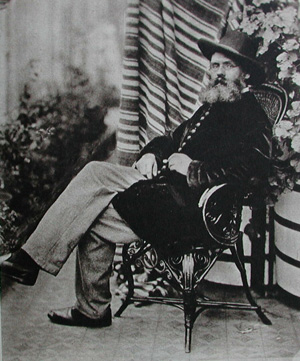How to research an image
- This month we have a submission from regular Signpost contributor and Picture of the Day coordinator Adam Cuerden, who explains how to research an image. This essay is not yet published elsewhere on Wikipedia, so please enjoy this first reading. – E
Sometimes, you might want to use an image, but key details aren't known. Let's look at this picture of Tom Taylor from the Library of Congress I stumbled across the other day:
Lovely! Given the lead image of Tom Taylor's article looked like this before:
-
Tom Taylor by... Lewis Carroll?
...this new image will make a great addition (not that the old one's bad, just not as good). And that... surprising attribution of the old photo should probably be filed away to double check. But the new image had a problem: The Library of Congress information page on it has (or possibly had) certain gaps:
| “ | Date Created/Published: [Place not identified] : [Publisher not identified], [between 1861 and 1880] | ” |
It also doesn't/didn't list a photographer at all. (Spoilers for later, but contacting the archive about your discoveries is an important step in doing research properly, so there's a chance I'll be describing things that aren't the case anymore, because they listened to me.)
So, how do you deal with this? Well, first thing I do is go into Google's image search and Google " Tom Taylor", and see if another copy of the photo comes up.
... At which point we learn that the list of names on Tom Taylor (disambiguation) is going to be a problem. Especially the actor. Let's try again with " Tom Taylor playwright".
That gets us to a WorthPoint entry – which is nearly useless, but tells us a copy of this image is on eBay. Worth a shot. Searching for Tom Taylor on eBay gets us to here, which is much more useful:
| “ | Photo by Lock and Whitfield. Taken from Men of Mark, a Gallery of Contemporary Portraits. Published by Sampson, Low, Marston, Searle and Rivington of Fleet Street c1875 | ” |
That's actually quite useful, and, since there's no real reason to disbelieve it, especially as the seller has a few dozen other prints in this style, which means they probably cut up that book, we have a start. Let's check Lock and Whitfield. Searching for them gets us to the United Kingdom's National Portrait Gallery, with, for example, this portrait of Yeames in the same style. Poking around there, and we can identify Lock and Whitfield as Samuel Robert Lock (1822–1881) and George Carpe Whitfield (1831–1917).
Copyright has checked out, there's some backup for our attribution. We're doing well. Would be better if we had a stronger source, but it's not bad, and it's fairly checkable if we can find the book.
I'd like to say that I then did sensible things to get the rest of the information. Like maybe find the National Portrait Gallery copy of this image with most of the information that I found after all of this was over. I got confused by how the National Gallery presented information, didn't click through, and missed it completely. Which is honestly a good example of how unfamiliarity with an archive – the United Kingdom's National Portrait Gallery has had a somewhat rocky relationship with Wikipedia, so I don't use it much – can cause you to miss things in your research.
What I did was go to Wikidata:Q2329794 and put the image in. While typing the file name, it makes suggestions for files you might mean with little thumbnails, and...
-
Hold on, what's this image?
... Well! Lower left hand corner. "Lock and Whitfield". We have a match! And the Rijksmuseum is a great source. Let's go to the link and see if we can confirm the other information we have...
A couple clicks later, and I'm looking at the Rijksmuseum entry of the book Men of Mark – which has all the information we need and more. It even has a publication date for the book!
Update all the image information, and now there's only one thing left to do: On the Library of Congress site, there's a section called " Ask a Librarian". Librarians, in my experience, are delighted when you help identify things in their collections. So, link the page for the image in question, pull up the Rijksmuseum documentation, and send off an email. Because improvements aren't just for Wikipedia.
Now if only I could figure out if Lewis Carroll was really going around photographing playwrights.
(As it turns out – remembering Carroll's real name is Charles Dodgson – he actually photographed a bunch of his famous friends. Who knew?)





Discuss this story